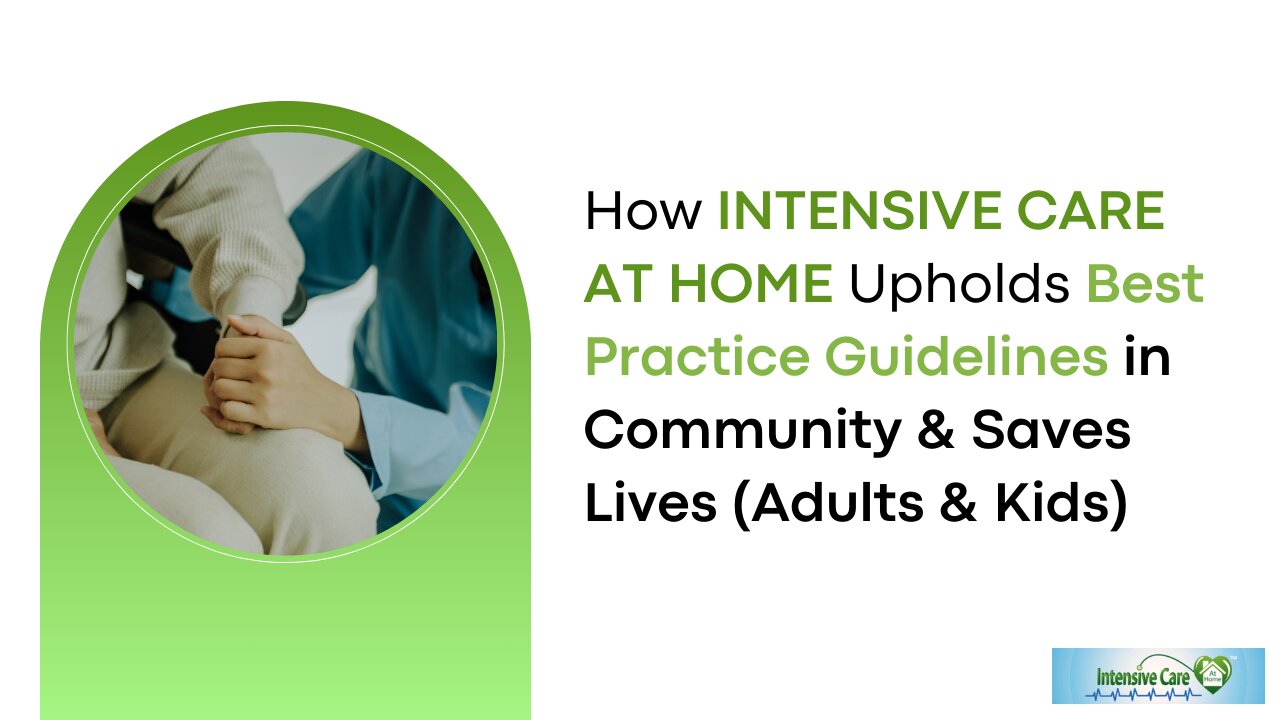Premium Only Content

How INTENSIVE CARE AT HOME Upholds Best Practice Guidelines in Community & Saves Lives (Adults&Kids)
How INTENSIVE CARE AT HOME Upholds Best Practice Guidelines in Community & Saves Lives (Adults & Kids)
Book your free 15-minute phone consultation here
http://intensivecarehotline.com/scheduling-appointment/
Call directly 24/7
+1 415-915-0090 USA/Canada
+44 118 324 3018 UK
+6141 094 2230 Australia
Email support@intensivecarehotline.com
Get 1:1 consulting and advocacy
1:1 phone counselling
http://intensivecarehotline.com/one-on-one-counselling/
Become a member for families of critically ill Patients in Intensive Care
https://intensivecarehotline.com/intensivecaresupport-org-membership/
Immediate action steps http://intensivecarehotline.com/take-control-take-charge/immediate-action-steps/
https://intensivecareathome.com
And if you need a medical record review, click on the link and we can help you with reviewing your loved one’s medical records while they’re in ICU.
https://intensivecarehotline.thrivecart.com/review-of-medical-records/
Facebook Page: https://www.facebook.com/ICUhotline
Twitter: https://twitter.com/icuhotline
Song: Jarico - Island Music
supported by@FreeBackgroundMusicForCreators
#BackgroundMusicWithoutLimitations
https://bit.ly/2XoXFnb
#icu
#intensivecare
#criticalcare
Hi. It’s Patrik Hutzel from intensivecareathome.com where we provide tailor-made solutions for long-term ventilated adults and children with tracheostomies at home, and where we also provide tailor-made solutions for hospitals and intensive care units at home whilst providing quality care for long-term ventilated adults and children with tracheostomies at home, otherwise medically complex clients at home, adults and children, which includes BIPAP (Bilevel Positive Airway Pressure), CPAP (Continuous Positive Airway Pressure), home tracheostomy care for adults and children that are not ventilated, Home TPN (Total Parenteral Nutrition), home IV potassium infusions, home IV magnesium infusions, as well as home IV antibiotics. We also provide port management, central line management, PICC (Peripherally Inserted Central Catheter) line management, as well as Hickman’s line management, and we also provide palliative care at home.
We have also sent, and we continue to send our critical care nurses into the home for emergency department bypass services. We have done so successfully for the Western Sydney Local Area Health District, their in-touch program.
Now, today, I want to talk about a video that was published on the 1st of August 2024. Now, the video was published by the Global Tracheostomy Collaborative, and the Global Tracheostomy Collaborative is a global organization that talks about ensuring the best possible care for every tracheostomy patient, that’s what they say anyway.
Today, I will actually dismantle that, and I will actually showcase that they’re not ensuring that the best possible care for every tracheostomy patient is given because, especially in this video that was published on the 1st of August 2024, it says Navigating the Journey with a Tracheostomy: Transitions Through Childhood and Beyond. I will play some of what’s been said on that video here today, and I will then talk more about that.
So, to give you some context, the Global Tracheostomy Collaborative says that they are supposedly advocating for the best possible care for every tracheostomy patient, and that is simply not accurate because they’re not talking about the Mechanical Home Ventilation Guidelines which are evidence-based, which are published on our website.
Now, where does that fit into context? The context is this, the Mechanical Home Ventilation Guidelines are evidence-based and are a result of over 25 years of Intensive Care at Home nursing in Germany, as well as of over 12 years Intensive Care at Home nursing in Australia.
Now, the Mechanical Home Ventilation Guidelines clearly state that it’s safe only to have critical care nurses at home with a minimum of two years critical care nursing experience, ideally with the postgraduate critical care nursing qualification, 24 hours a day, once again, for adults and children at home on ventilation with tracheostomy, but also for tracheostomy without ventilation.
Now, if organizations do not adhere to those best practice standards, children have died, or adults have died. We know of at least four adults and children that have died at home on ventilation with tracheostomy or with tracheostomy without ventilation that have died in the hands of support workers or family members who simply could not manage medical emergencies. Now, if we know of four, there is probably more.
Continue reading at: https://intensivecareathome.com/how-intensive-care-at-home-upholds-best-practice-guidelines-in-community-saves-lives-adults-kids/
-
 0:53
0:53
Intensive Care Hotline
5 days agoAmerican Journal of Medicine Confirmed: Nasogastric Tubes are Safer Than PEG Tubes
81 -
 LIVE
LIVE
The Dan Bongino Show
2 hours agoTrump Is Cancelling DEI And Cancel Culture (Ep. 2424) - 02/17/2025
108,905 watching -
 DVR
DVR
Timcast
1 hour agoDemocrat Swamp IMPLODES, CBS Runs DAMAGE Control For Democrats, Gets ROASTED By Elon | Timcast LIVE
11.4K25 -
 LIVE
LIVE
RealAmericasVoice
7 hours agoWAR ROOM WITH STEVE BANNON AM EDITION
7,472 watching -
 LIVE
LIVE
Wendy Bell Radio
6 hours agoAmerica Drops The Gloves
11,415 watching -
 LIVE
LIVE
Steven Crowder
2 hours agoGeorge Washington, Our First President | 3 in 3 Special
25,397 watching -
 1:03:57
1:03:57
Kyle Fortch
2 hours agoDJ Chill: DJing For Jelly Roll, SOLD OUT Tour, Performing at Hometown Arena | THE ONE SHEET S1E4
22 -
![The Deep State Spied On Trump & Sabotaged 2020 Operation To Oust Maduro [EP 4440-8AM]](https://1a-1791.com/video/fwe1/94/s8/1/F/5/k/Z/F5kZx.0kob-small-The-Deep-State-Spied-On-Tru.jpg) 4:05:26
4:05:26
The Pete Santilli Show
13 hours agoThe Deep State Spied On Trump & Sabotaged 2020 Operation To Oust Maduro [EP 4440-8AM]
6.52K2 -
 LIVE
LIVE
Rethinking the Dollar
38 minutes agoMonday Morning Check-In: Will THE 50-YEAR FORT KNOX GOLD SCANDAL BE EXPOSED?
213 watching -
 1:32:36
1:32:36
Game On!
15 hours ago $5.74 earnedPresident Trump TAKES OVER the Daytona 500!
18.7K11